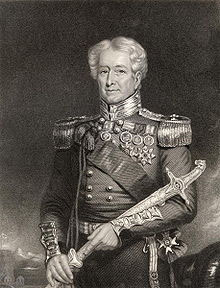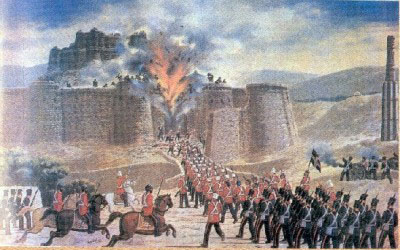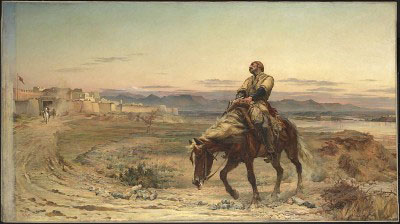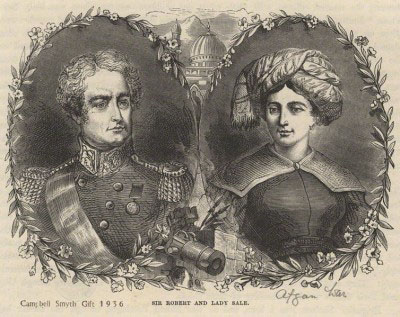Sale is a city in the Gippsland region of Victoria with a population of around 14,000.
Two famous Gippsland explorers, Paul Strzelecki and Angus McMillan, passed through the immediate area around 1840. The first white settler was Archibald McIntosh who arrived in 1844 and established his ‘Flooding Creek’ property on the flood plain country.
In the 1840s, drovers heading south to Port Albert crossed Flooding Creek and were confronted with the difficult marsh country around the Thomson and Latrobe rivers. A punt operated across the Latrobe River until a toll bridge was erected.
A new settlement named ‘Sale’ was gazetted in 1851. It was named in tribute to General Sir Robert Sale, a British army officer who won fame in the first Afghan war before being killed in battle in India in 1845.

In 1838, on the outbreak of the First Anglo-Afghan War, Brevet-Colonel Sale was assigned to the command of the 1st Bengal Brigade of the army assembling on the Indus. His column arrived at Kandahar in April 1839, and in May it occupied the Herat plain. The Kandahar force next set out on its march to Kabul, and a month later Ghazni was stormed, Sale in person leading the storming column and distinguishing himself in single combat.

Ghazni was well provisioned, and on its supplies the army finished its march to Kabul easily. The British achieved a decisive victory over Dost Mohammad Khan’s troops, led by one of his sons. In August 1839, after almost thirty years absence, Shuja was again enthroned as Shah in Kabul, with the support of the British East India Company.
For his services during the campaign Sale was made a Knight Commander of the Order of the Bath and received the local rank of major-general, as well as the Shah’s order of the Durrani Empire.
Sale was left as second-in-command of an occupation force of 8,000 in Kabul and conducted several small campaigns; ending with the action of Parwan which led directly to the surrender of Dost Mahommed Khan. By this time the garrison force had settled down to the quiet life of cantonments, and Lady Sale and her daughter came to live in Kabul.
But the new policy of the Indian government in stopping the subsidy to the frontier tribes roused them into hostility, and Sale’s brigade received orders to clear the line of communication to Peshawar. Sale’s brigade marched from Kabul in late October and after severe fighting entered Jalalabad on 12 November 1841.
During the advance to Jalalabad, Sale received news of the murder of Sir Alexander Burnes – a senior British political agent – along with orders to return with all speed to Kabul. These orders, for various reasons, he decided to ignore; suppressing his personal desire to return to protect his wife and family, he gave orders to push on, and on occupying Jalalabad at once set about making the old and half-ruined fortress fit to stand a siege.
On 1 January 1842, an agreement was reached that provided for the safe exodus of the British garrison and its dependants from Afghanistan. Five days later, the withdrawal began. The departing British contingent numbered around 16,500, of which about 4,500 were military personnel, and over 12,000 were camp followers. The military force consisted mostly of Indian units and one British battalion, 44th Regiment of Foot.
The column was attacked by Ghilzai warriors as they struggled through the snowbound passes. The evacuees were killed in huge numbers as they made their way down the 48 km of treacherous gorges and passes along the Kabul River valley between Kabul and Gandamak, and were massacred at the Khurd Karbul Pass before a survivor reached the besieged garrison at Jalalabad.
The force had been reduced to fewer than forty men by a withdrawal from Kabul that had become, towards the end, a running battle through two feet of snow. The ground was frozen; the men had no shelter and had little food for weeks. The remnants of the 44th were all killed except Captain James Souter, Sergeant Fair and seven soldiers who were taken prisoner. The only Briton to reach Jalalabad was Dr William Brydon.

After this disaster, Shuja was assassinated and Dost Mohammed Khan gained the throne.
Amongst those taken captive during the march were Lady Sale and her youngest daughter Alexandrina, along with her husband Lieutenant John Sturt and their newly born daughter. Sturt was fatally injured by three dagger wounds to the abdomen, with Lady Sale nursing her son-in-law in his final hours. Upon his death she secured him a Christian burial; he was the only fallen officer to receive such a burial. Her courageous and defiant actions meant that she endangered herself frequently; she was shot in the wrist, with the bullet lodging there.
The British launched a punitive expedition from April to September 1842 and recaptured Kabul. After nine months in captivity, Lady Sale bribed the Afghan officers into releasing them, and was then subsequently rescued by Sir Richmond Shakespear on 17 September 1842.
Throughout her time as a captive, Lady Sale kept a diary, detailing the events of the ordeal. A year later Lady Sale published her journal (Journal of the Disasters in Afghanistan, London, 1843) which documented her experiences throughout the campaign and the book became a best seller.
Meanwhile, the East India Company decided that an ongoing occupation of Afghanistan would be too dangerous, and unprofitable, so the country was evacuated in December 1842. Dost Mohammed Khan resumed the throne and reigned until 1863.
Sir Robert Sale died in action during the First Sikh War at the Battle of Mudki in December 1845, leaving Florentia widowed. After her husband’s death she received a pension of £500 per annum in light of her conduct as a prisoner and her husband’s military services. She remained for the most part of the rest of life in India.
A SBS TV documentary in 2012 “Afghanistan: The Great Game” asserted that Sale was named after Lady Sale and not her husband, but in any event the naming of Sale is a lasting tribute to a remarkable couple and their incredible experiences.

Contact Marcus Fielding about this article.






